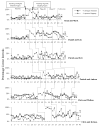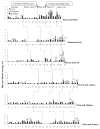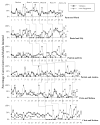Evaluation of a Sibling-Mediated Imitation Intervention for Young Children with Autism
- PMID: 24339726
- PMCID: PMC3856875
- DOI: 10.1177/1098300712437044
Evaluation of a Sibling-Mediated Imitation Intervention for Young Children with Autism
Abstract
Parents and peers have been successful at implementing interventions targeting social interactions in children with autism; however, few interventions have trained siblings as treatment providers. This study used a multiple-baseline design across six sibling dyads (four children with autism) to evaluate the efficacy of sibling-implemented reciprocal imitation training. All six typically developing siblings were able to learn and use contingent imitation, four of the six siblings were able to learn and use linguistic mapping, and all six siblings increased their use of at least one component of the imitation training procedure. Three of the four children with autism showed increases in overall imitation and all four showed evidence of increases in joint engagement. Parents and siblings reported high satisfaction with the intervention and ratings by naïve observers indicated significant changes from pre- to post-treatment. These results suggest that sibling-implemented reciprocal imitation training may be a promising intervention for young children with autism.
Keywords: children with autism; family-based interventions; imitation; siblings.
Figures



Similar articles
-
A Sibling-Mediated Intervention for Children with Autism Spectrum Disorder: Using the Natural Language Paradigm (NLP).J Autism Dev Disord. 2018 May;48(5):1508-1522. doi: 10.1007/s10803-017-3404-x. J Autism Dev Disord. 2018. PMID: 29170941
-
Examination of the Effectiveness and Acceptability of a Play-Based Sibling Intervention for Children with Autism: A Single-Case Research Design.Educ Treat Children. 2021;44(4):249-267. doi: 10.1007/s43494-021-00043-5. Epub 2021 Aug 16. Educ Treat Children. 2021. PMID: 34421194 Free PMC article.
-
The implementation of reciprocal imitation training in a Part C early intervention setting: A stepped-wedge pragmatic trial.Autism Res. 2021 Aug;14(8):1777-1788. doi: 10.1002/aur.2522. Epub 2021 May 6. Autism Res. 2021. PMID: 34080761 Clinical Trial.
-
A Systematic Review of Family-Mediated Social Communication Interventions for Young Children with Autism.Rev J Autism Dev Disord. 2022;9(2):208-234. doi: 10.1007/s40489-021-00249-8. Epub 2021 Apr 1. Rev J Autism Dev Disord. 2022. PMID: 33821200 Free PMC article. Review.
-
The role of imitation in video-based interventions for children with autism.Dev Neurorehabil. 2013 Aug;16(4):283-9. doi: 10.3109/17518423.2012.758185. Epub 2013 Jan 16. Dev Neurorehabil. 2013. PMID: 23323880 Review.
Cited by
-
A hybrid type I randomized effectiveness-implementation trial of a Naturalistic Developmental Behavioral Intervention in the Part C early intervention system: study protocol.BMC Pediatr. 2025 Apr 1;25(1):263. doi: 10.1186/s12887-025-05587-8. BMC Pediatr. 2025. PMID: 40170032 Free PMC article.
-
Having Older Siblings is Associated with Less Severe Social Communication Symptoms in Young Children with Autism Spectrum Disorder.J Abnorm Child Psychol. 2016 Nov;44(8):1613-1620. doi: 10.1007/s10802-016-0133-0. J Abnorm Child Psychol. 2016. PMID: 26843212
-
Creative Yoga Intervention Improves Motor and Imitation Skills of Children With Autism Spectrum Disorder.Phys Ther. 2019 Nov 25;99(11):1520-1534. doi: 10.1093/ptj/pzz115. Phys Ther. 2019. PMID: 31765484 Free PMC article.
-
A Sibling-Mediated Intervention for Children with Autism Spectrum Disorder: Using the Natural Language Paradigm (NLP).J Autism Dev Disord. 2018 May;48(5):1508-1522. doi: 10.1007/s10803-017-3404-x. J Autism Dev Disord. 2018. PMID: 29170941
-
Improving Collaborative Play Between Children with Autism Spectrum Disorders and Their Siblings: The Effectiveness of a Robot-Mediated Intervention Based on Lego® Therapy.J Autism Dev Disord. 2015 Nov;45(11):3746-55. doi: 10.1007/s10803-014-2326-0. J Autism Dev Disord. 2015. PMID: 25428293 Clinical Trial.
References
-
- American Psychiatric Association. Diagnostic and statistical manual of mental disorders. 4. Washington, DC: Author; 2000. text revision.
-
- Bayley N. Bayley Scales of Infant and Toddler Development. 3. San Antonio, TX: Harcourt Assessment, Inc; 2006.
-
- Celiberti DA, Harris SL. Behavioral intervention for siblings of children with autism: A focus on skills to enhance play. Behavior Therapy. 1993;24:573–599.
-
- Coe DA, Matson JL, Craigie CJ, Gossen MA. Play skills of autistic children: assessment and instruction. Child and Family Behavior Therapy. 1991;13:13–40.
-
- Drew A, Baird G, Baron-Cohen S, Cox A, Slonims V, Wheelwright S, et al. A pilot randomised control trial of a parent training intervention for pre-school children with autism. European Child and Adolescent Psychiatry. 2002;11:266–272. - PubMed
Grants and funding
LinkOut - more resources
Full Text Sources
